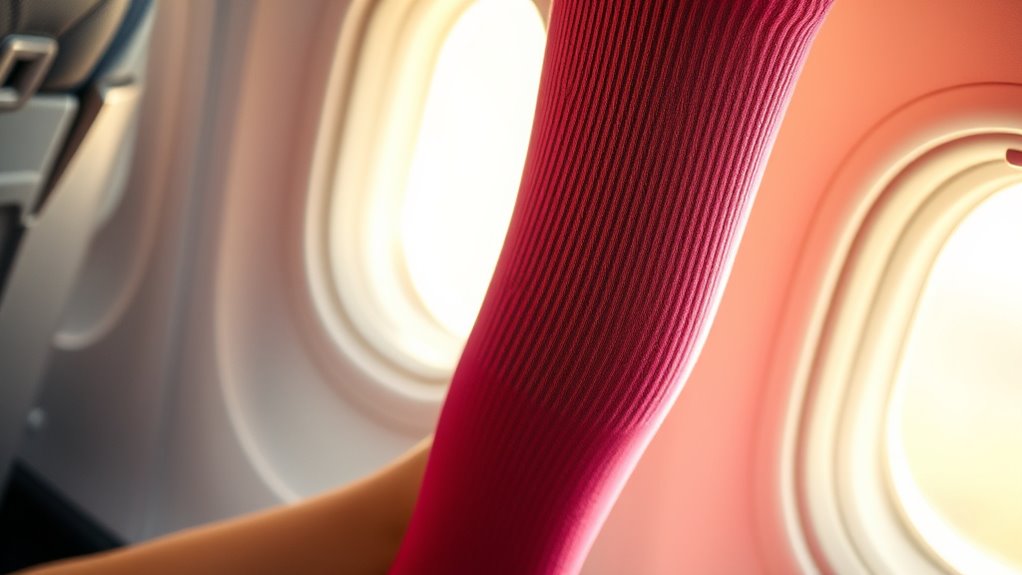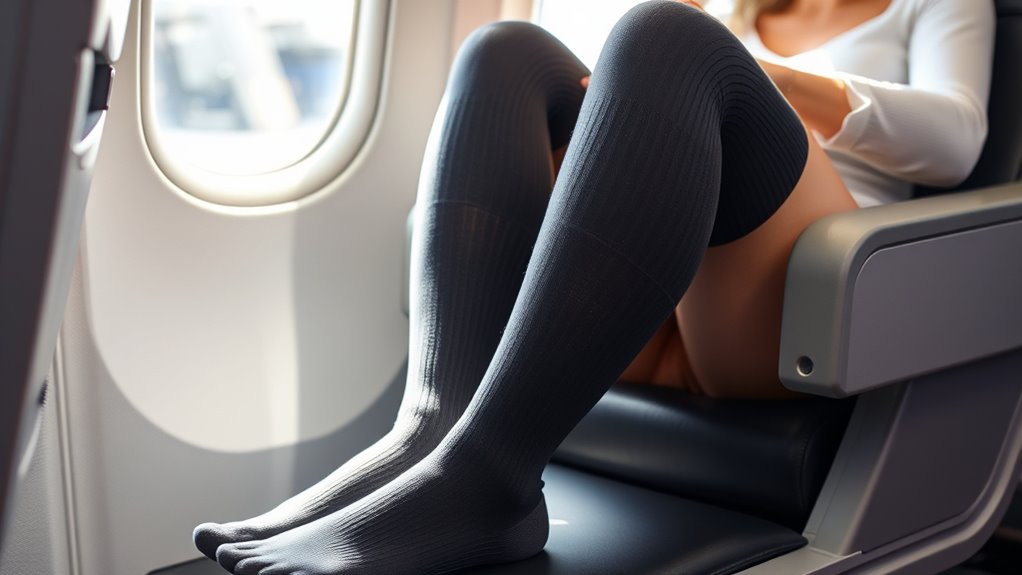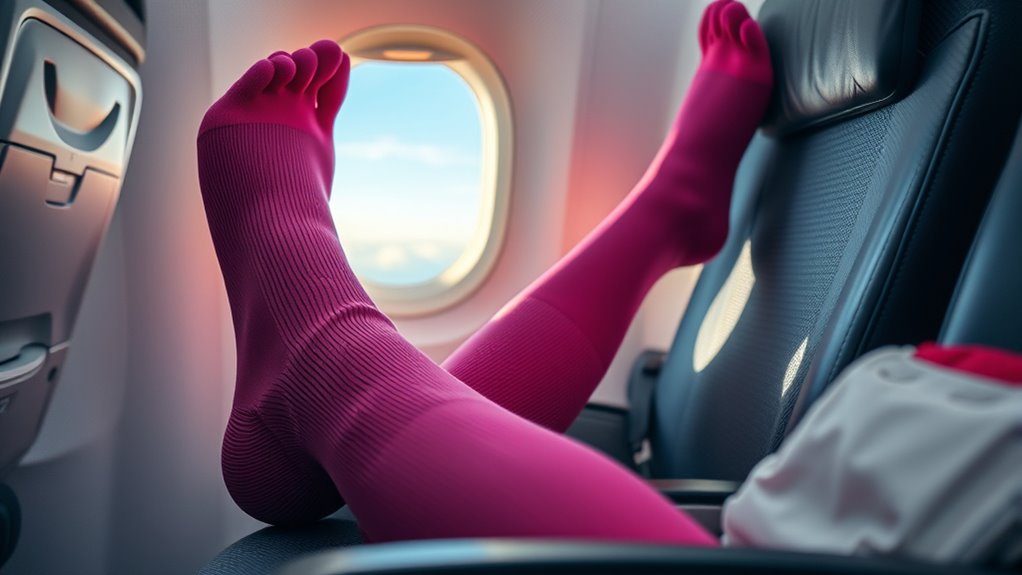If you take long flights, compression socks can boost circulation, reduce swelling, and lower the risk of blood clots. They apply graduated pressure, supporting your legs and encouraging blood flow back to your heart. While they’re especially helpful if you already have circulation issues or sit for hours, others find they improve comfort and recovery. Want to discover how to choose the right pair and if you really need them? Keep exploring to learn more.
Key Takeaways
- Compression socks promote healthy circulation, reduce swelling, and prevent blood clots during long flights.
- They are especially recommended for travelers with circulation issues, varicose veins, or a history of clots.
- Proper fit and compression level (15-20 mmHg) maximize comfort and health benefits.
- Not everyone needs compression socks; healthy travelers without risk factors may not require them.
- Technological advancements continue to improve their effectiveness and comfort, making them a valuable travel accessory for some.
How Compression Socks Work to Improve Circulation

Compression socks work by applying graduated pressure to your legs, which helps improve blood flow. This pressure is firmest at the ankle and gradually decreases up your calf, encouraging blood to move upward efficiently. As a result, your legs experience better circulation, reducing the risk of blood pooling and swelling during long flights. Additionally, compression socks offer muscle support, stabilizing your calves and reducing fatigue. They help prevent micro-tears in muscles caused by repetitive movement, keeping your legs feeling energized. The improved blood flow delivers oxygen and nutrients more effectively to your muscles, aiding recovery and minimizing discomfort. Proper tuning of compression levels can further optimize their benefits. Using natural materials and ensuring proper fit can enhance comfort and effectiveness. Additionally, filter technology advancements contribute to more comfortable and effective compression designs, making extended periods of sitting much more comfortable and healthier for your legs. By supporting your circulatory system and muscles, compression socks can make extended periods of sitting much more comfortable and healthier for your legs. Innovations in compression technology continue to enhance their effectiveness and comfort for travelers.
Signs That Signal You Might Benefit From Compression Wear

If you’ve been experiencing discomfort or swelling in your legs during or after long periods of sitting, it might be time to contemplate whether compression wear could help. Persistent leg heaviness, aching, or visible veins are clear signs you might benefit. These symptoms often align with medical conditions like varicose veins or deep vein thrombosis, which compression socks can help manage. Additionally, as compression socks gain popularity in fashion trends, more people wear them for style and comfort, even without medical issues. If your legs feel tired or look swollen after flights or extended sitting, compression wear could improve circulation and reduce discomfort. Recognizing these signs helps you decide if incorporating compression socks into your routine is a smart choice for your health and style. Understanding blood flow is essential to appreciating how compression garments support your circulatory health. Moreover, wearing compression socks can help prevent the development of blood clots, especially during prolonged periods of inactivity. Proper compression levels and fit are crucial to achieving these benefits effectively, as advances in on-device AI capabilities are improving the customization and effectiveness of compression therapy.
Different Types and Compression Levels Available

Have you ever wondered about the different types and compression levels available in compression socks? There are various compression level options, ranging from mild to firm, designed to suit different needs and comfort levels. Mild compression (around 8-15 mmHg) is ideal for everyday use and minor swelling, while moderate (15-20 mmHg) offers more support for travelers or those with moderate symptoms. Firm compression (20-30 mmHg) provides maximum pressure for specific medical conditions. Sock material choices also vary; you’ll find options like nylon, spandex, and cotton blends, each offering different breathability, durability, and stretch. Proper fit is essential to maximize the benefits and prevent discomfort or circulation issues. Selecting the appropriate compression level can also influence your comfort and effectiveness. Understanding the benefits of compression therapy can help you make an informed choice for your needs. Additionally, compression maintenance involves proper cleaning and care to ensure the longevity and effectiveness of your socks, which can be guided by manufacturer instructions. Spiritual energy also influences overall well-being, and choosing the right compression level can help support your physical health on your journey.
Who Should Consider Using Compression Socks During Flights

Long flights can increase the risk of blood clots, swelling, and discomfort, making compression socks beneficial for many travelers. If you’re pregnant, wearing compression socks can enhance pregnancy safety by promoting healthy blood flow and reducing swelling. Athletes often use them to improve performance and recovery, and they can benefit from compression during long flights to maintain circulation. If you’ve experienced circulation issues, varicose veins, or are recovering from surgery, compression socks can provide extra support. Travelers with a family history of blood clots or clotting disorders should consider them as a precaution. Even if you’re generally healthy, wearing compression socks for long durations can help prevent discomfort and promote circulation, making your flight more comfortable and safer. Proper sizing and fit are essential to ensure maximum effectiveness and comfort during use.
Potential Benefits and Limitations of Wearing Compression Socks

Wearing compression socks during long flights offers several notable benefits, primarily by promoting healthy blood circulation and reducing swelling. They can also enhance athletic performance if you stay active after your flight. However, there are limitations to contemplate. Some people experience skin irritation or discomfort from wearing them too long. Additionally, understanding the emotional support that loved ones provide can help you feel more comfortable and confident in your choice to wear compression socks during travel. Recognizing medical guidelines can further ensure safe usage tailored to individual health needs. Being aware of proper fitting techniques can also optimize their effectiveness and comfort during use. Consulting fabric decorating markers options might inspire personalized touches to your travel gear, making the experience more enjoyable.
Tips for Choosing the Right Pair for Travel

Choosing the right compression socks for travel involves considering factors like size, compression level, and material to guarantee comfort and effectiveness. To make a smart choice, keep these tips in mind:
Pick the perfect travel compression socks by focusing on fit, compression level, and durable, moisture-wicking materials.
- Check for proper fit — ill-fitting socks can cause discomfort and reduce benefits. Proper fit is especially important when considering comfortable footwear for long flights.
- Select the right compression level — 15-20 mmHg suits most travelers, but consult your doctor for personalized advice.
- Prioritize material durability — look for moisture-wicking fabrics that withstand frequent washing and movement. Additionally, understanding pressure levels can help you choose the most suitable compression socks for your needs.
- Stay aware of fashion trends — trendy designs and colors can boost your confidence and match your travel style.
- Consider astrological compatibility — some believe that zodiac signs can influence personal charisma and confidence, potentially enhancing your overall travel experience.
Are Compression Socks a Necessary Travel Essential?

Are compression socks a travel essential or just a helpful accessory? It depends on your needs and preferences. While fashion trends often show compression socks as stylish, their primary purpose is health-related, helping prevent blood clots and swelling during long flights. Some travelers swear by them, especially those with medical conditions or a history of circulation issues. Cultural differences also influence perceptions—certain cultures prioritize comfort and health, making compression socks more common, while others view them as unneeded. Ultimately, if you’re concerned about swelling or blood flow, compression socks can be a practical, necessary item. If you’re healthy and comfortable without them, they’re more of a helpful accessory than a must-have. Decide based on your comfort and travel habits. Additionally, understanding AI’s role in cybersecurity and healthcare highlights how technological innovations contribute to health and safety. As advancements in medical device technology continue, the integration of compression garments with health monitoring systems is becoming increasingly feasible. Recognizing the importance of lifestyle choices can also influence your decision on whether to use compression socks during travel. Moreover, some studies suggest that compression therapy may benefit certain individuals by promoting circulation and reducing discomfort during long periods of inactivity.
Frequently Asked Questions
Can Compression Socks Prevent Deep Vein Thrombosis During Flights?
Yes, compression socks can help prevent deep vein thrombosis (DVT) during flights by improving blood flow in your legs. They apply gentle pressure, reducing the risk of blood clots forming during long periods of immobility. Wearing compression socks encourages healthy clot prevention, making them a useful tool for travelers. Just guarantee you choose the right compression level and fit for maximum effectiveness and comfort throughout your flight.
How Long Before a Flight Should I Start Wearing Compression Socks?
Imagine boarding a plane with your legs feeling light and supported. You should start wearing compression socks about 1 to 2 hours before your flight, ensuring they’re properly fitted for maximum benefit. To get the timing right, put them on while your legs are still warm and relaxed. Follow sock fitting tips like choosing the right compression level and ensuring a snug, comfortable fit to prevent circulation issues during your journey.
Are There Any Risks or Side Effects From Wearing Compression Socks?
Wearing compression socks can cause risks like skin irritation or worsen circulation issues if you have underlying conditions. To avoid problems, choose the right compression level and make certain a proper fit. If you notice discomfort, redness, or swelling, remove the socks and consult a healthcare professional. It’s especially important to be cautious if you have sensitive skin or circulation problems, so always follow medical advice.
Do Compression Socks Help With Swelling After Long Flights?
Yes, compression socks help with swelling reduction after long flights by applying gentle pressure that promotes improved circulation. This increased blood flow prevents fluid buildup in your legs and ankles, reducing discomfort and swelling. Wearing compression socks during and after your flight can make a noticeable difference, especially if you’re prone to swelling or have circulation concerns. They’re a simple, effective way to support your legs and feel more comfortable post-travel.
Can Pregnant Travelers Benefit From Using Compression Socks on Flights?
You can definitely benefit from compression socks during flights if you’re pregnant, as they help reduce pregnancy discomfort and improve fetal circulation. Studies show pregnant travelers are at higher risk for blood clots, with a 30% increased risk compared to non-pregnant travelers. Compression socks promote healthy blood flow, easing swelling and discomfort, and supporting your baby’s circulation during long flights. Wearing them is a simple step to stay comfortable and safe on your journey.
Conclusion
Whether you need compression socks for long flights depends on your personal health and comfort. Think of them as a trusty sidekick, ready to support your circulation and keep discomfort at bay. If you’re prone to swelling or have circulation issues, they might just be the travel essential you didn’t know you needed. Ultimately, choosing the right pair can turn a long haul into a smoother journey, making your flight feel like a breeze rather than a storm.









